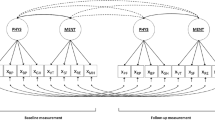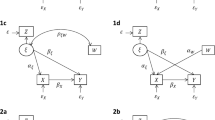Abstract
This paper considers a situation in which cause–effect relationships among variables can be described by a linear structural equation model (linear SEM) and the corresponding directed acyclic graph (DAG). By considering a set of covariates that satisfies the back-door criterion, we formulate (1) the variances of the estimated mean response and (2) the mean squared error (MSE) of the predicted response, with external intervention in which a treatment variable is set to be a certain constant value. The variance and MSE formulas proposed in this paper are exact, unlike those in most previous studies regarding the problem of estimating total effects. In addition, we compare the performance of the simple regression model with that of the predicted response with the external intervention. Furthermore, we apply the present results to statistical quality control.





Similar content being viewed by others
References
Bollen, K.A.: Structural Equations with Latent Variables. Wiley, Hoboken (1989)
Bowden, R.J., Turkington, D.A.: Instrumental Variables. Cambridge University Press, Cambridge (1984)
Brito, C.: Graphical methods for identification in structural equation models. UCLA Computer Science Department, Technical Report (R-314), PhD Thesis (2004)
Cai, Z., Kuroki, M.: On identifying total effects in the presence of latent variables and selection bias. In: Proceedings of the 24th Conference on Uncertainty in Artificial Intelligence, pp. 62–69 (2008)
Chan, H., Kuroki, M.: Using descendants as instrumental variables for the identification of direct causal effects in linear SEMs. In: Proceedings of the 13th International Conference on Artificial Intelligence and Statistics, pp. 73-80 (2010)
Chen, B.R.: Graphical methods for linear structural equation modeling. UCLA Computer Science Department, Technical Report, PhD Thesis (2017)
Cox, D.R., Wermuth, N.: Multivariate Dependencies: Models, Analysis and Interpretation. Chapman and Hall/CRC, Boca Raton (2014)
Duncan, O.D.: Introduction to Structural Equation Models. Academic Press, Cambridge (1975)
Garcia, L., Spielvogel, S., Sullivant, S.: Identifying causal effects with computer algebra. In: Proceedings of the 26th Conference on Uncertainty in Artificial Intelligence, pp. 193–200 (2010)
Ghosh, S., Schucany, W.R., Smith, W.B.: Statistics of Quality. CRC Press, Boca Raton (1996)
Henckel, L., Perkovic, E., Maathuis, M.H.: Graphical criteria for efficient total effect estimation via adjustment in causal linear models. arXiv preprint arXiv:1907.02435 (2019)
Kuroki, M., Cai, Z.: Selection of identifiability criteria for total effects by using path diagrams. In: Proceedings of the 20th Conference on Uncertainty in Artificial Intelligence, pp. 333–340 (2004)
Kuroki, M.: Selection of post-treatment variables for estimating total effect from empirical research. J. Jpn. Stat. Soc. 30, 129–142 (2000)
Kuroki, M.: Optimizing a control plan using a structural equation model with an application to statistical process analysis. J. Appl. Stat. 39, 673–694 (2012)
Kuroki, M., Miyakawa, M.: Covariate selection for estimating the causal effect of control plans using causal diagrams. J. R. Stat. Soc. Ser. B 65, 209–222 (2003)
Kuroki, M., Miyakawa, M.: Graphical identifiability criteria for total effects in studies with an unobserved response Variable. Behaviormetrika 31, 13–28 (2004)
Kuroki, M., Pearl, J.: Measurement bias and effect restoration in causal inference. Biometrika 101, 423–437 (2014)
Maathuis, M.H., Colombo, D.: A generalized back-door criterion. Ann. Stat. 43, 1060–1088 (2015)
Mardia, K.V., Kent, J.T., Bibby, J.M.: Multivariate Analysis. Academic Press, Cambridge (1979)
Nandy, P., Maathuis, M.H., Richardson, T.S.: Estimating the effect of joint interventions from observational data in sparse high-dimensional settings. Ann. Stat. 45, 647–674 (2017)
Okuno, T., Katayama, Z., Kamigori, N., Itoh, T., Irikura, N., Fujiwara, N.: Kougyou ni okeru Tahenryou Data no Kaiseki (In Japanese). JUSE Press, Tokyo (1986)
Pearl, J.: Probabilistic Reasoning in Intelligence Systems. Morgan Kaufmann, Burlington (1988)
Pearl, J.: Causality: Models, Reasoning, and Inference, 2nd edn. Cambridge University Press, Cambridge (2009)
Shan, N., Guo, J.: Covariate selection for identifying the effects of a particular type of conditional plan using causal networks. Front. Math. China 5, 687–700 (2010)
Shan, N., Guo, J.: Covariate selection for identifying the causal effects of stochastic interventions using causal networks. J. Stat. Plan. Inference 142, 212–220 (2012)
Stanghellini, E., Pakpahan, E.: Identification of causal effects in linear models: beyond instrumental variables. Test 24, 489–509 (2015)
Tian, J.: A criterion for parameter identification in structural equation models. In: Proceedings of the 23rd Conference on Uncertainty in Artificial Intelligence, pp. 392-399 (2007b)
Tian, J.: Identifying linear causal effects. In: Proceeding of the 19th National Conference on Artificial Intelligence, pp. 104-111 (2004)
Tian, J.: On the identification of a class of linear models. In: Proceedings of the 22nd National Conference on Artificial Intelligence, pp. 1284-1289 (2007a)
Wright, S.: The theory of path coefficients: a reply to Niles’ criticism. Genetics 8, 239–255 (1923)
Wright, S.: The method of path coefficients. Ann. Math. Stat. 5, 161–215 (1934)
Acknowledgements
This work was partially supported by the Japan Society for the Promotion of Science (JSPS), Grant no. 15K00060.
Author information
Authors and Affiliations
Corresponding author
Additional information
Publisher's Note
Springer Nature remains neutral with regard to jurisdictional claims in published maps and institutional affiliations.
Rights and permissions
About this article
Cite this article
Kuroki, M., Nanmo, H. Variance formulas for estimated mean response and predicted response with external intervention based on the back-door criterion in linear structural equation models. AStA Adv Stat Anal 104, 667–685 (2020). https://doi.org/10.1007/s10182-020-00372-7
Received:
Accepted:
Published:
Issue Date:
DOI: https://doi.org/10.1007/s10182-020-00372-7




